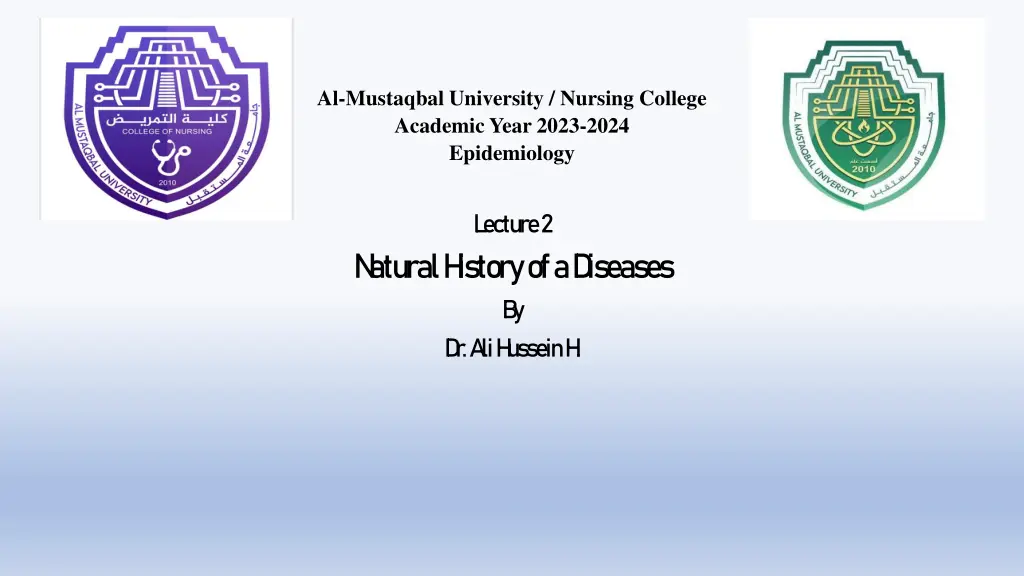
Understanding the Natural History of Diseases: A Comprehensive Overview
Explore the stages of the natural history of diseases, from susceptibility to recovery, disability, or death. Gain insights into disease progression, clinical manifestations, and outcomes, as well as the importance of prevention in maintaining optimal health.
Download Presentation

Please find below an Image/Link to download the presentation.
The content on the website is provided AS IS for your information and personal use only. It may not be sold, licensed, or shared on other websites without obtaining consent from the author. If you encounter any issues during the download, it is possible that the publisher has removed the file from their server.
You are allowed to download the files provided on this website for personal or commercial use, subject to the condition that they are used lawfully. All files are the property of their respective owners.
The content on the website is provided AS IS for your information and personal use only. It may not be sold, licensed, or shared on other websites without obtaining consent from the author.
E N D
Presentation Transcript
Al-Mustaqbal University / Nursing College Academic Year 2023-2024 Epidemiology L ecture 2 N atural H istory of a D iseases B y D r. A li H ussein H .
Natural history of disease The natural history of disease refers to the progression of disease process in an individual over time, in the absence of intervention. There are four stages: 1. Stage of susceptibility 2. Stage of pre-symptomatic (sub-clinical) disease 3. Stage of clinical disease 4. Stage of recovery , disability or death
1. Stage of susceptibility In this stage, disease has not yet developed, but the groundwork has been laid by the presence of factors that favor its occurrence. Example: unvaccinated child is susceptible to measles.
2. Stage of pre-sym ptom atic (sub-clinical) disease In this stage there are no manifestations of the disease but pathologic changes (damages) have started to occur in the body. The disease can only be detected through special tests since the signs and symptoms of the disease are not present. Examples: Detection of antibodies against HIV in an apparently healthy person. Oval of intestinal parasite in the stool of apparently healthy children.
3. The C linical stage At this stage the person has developed signs and symptoms of the disease. The clinical stage of different diseases differs in duration, severity and outcome. The outcomes of this stage may be recovery, disability or death. Examples: Common cold has a short and mild clinical stage and almost everyone recovers quickly. Polio has a severe clinical stage and many patients develop paralysis becoming disabled for the rest of their lives. Rabies has a relatively short but severe clinical stage and almost always results in death. Diabetes Mellitus has a relatively longer clinical stage and eventually results in death if the patient is not properly treated.
4. Stage of recovery, disability or death Some diseases run their course and then resolve completely either spontaneously or by treatment. In others the disease may result in a residual defect, leaving the person disabled for a short or longer duration. Still, other diseases will end in death. Disability is limitation of a person's activities including his role as a parent . etc Examples: Meningitis may result in deafness. Meningitis may also result in death.
P revention Prevention is to make the occurrence of some thing like disease, accident, which is anticipated, impossible. This can be achieved at three levels (levels of prevention) 1- Primary prevention 2. Secondary prevention 3. Tertiary prevention
P rim ary prevention Measures are aimed at individuals in the Susceptibility stage All measures that are applicable before the onset of disease through: Health promotion. Specific protection.
a. Health promotion. Health promotion. :The process of enabling people to increase control over their health and its determinants, and thereby improve their health. Health promotion consists of all the activities which are not aimed at any specific diseases but serve to improve the host factor in epidemiologic triangle. 1. Health education. 2. Environmental modification (reducing air pollution, safe water, sanitary latrines, control of insects and rodents, improving housing). 3. Engineering lifestyle (antismoking campaign.). 4. Genetic and marriage counseling (to prevent congenital diseases, i.e. Thalassemia).
b. Specific protection. The measures which target particular diseases. The idea of specific protection, especially that killer diseases could be stopped by simple interventions such as Immunization. Nutrient supplementation (vitamin A, iodine). prophylaxis (prior medication to at risk population). Protection against occupational hazards (masks for workers). Avoiding allergens (for asthmatics).
Secondary prevention Secondary prevention Measures focus on the Sub-clinical stage and the early clinical stage. This is applied after the onset of disease through early detection: prompt treatment of disease.
Secondary prevention Early detection 1. Screening tests are done in healthy population of a community. 2. Case finding means diagnosing something else in patient other than his chief complaint. 3. Special medical examination of risk groups. Prompt treatment: A quick cure, helps the patient as well as stops further spread of disease.
Tertiary prevention Tertiary prevention Measures are directed mainly at the recovery, disability or death stage. Their purpose is to reduce or eliminate long-term impairments and disabilities, minimize suffering, optimize function.
Tertiary prevention Tertiary prevention Tertiary prevention through limitation of disability and rehabilitation. There are four dimensions of rehabilitation 1. Medical: If possible restoration of function (i.e physiotherapy) 2. Vocational: Restoration of capacity to earn a livelihood (training and creating jobs) 3. Social: Reintroduction into family, and society as a whole and involving everyone to maintain the same relationship with this person. 4. Psychic: Restoration of self-esteem and confidence
HAVE A NICE DAY Thank you 05.05.2025 17






















